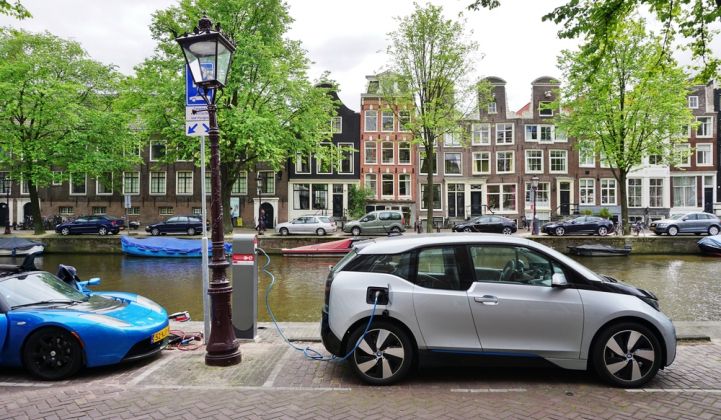European electric-vehicle adoption won’t take off until at least 2025, according to research by GTM’s parent company Wood Mackenzie.
The high cost of new cars, coupled with limited battery life and vehicle range, is hampering the take-up of EVs compared to internal combustion engine (ICE) vehicles, says Wood Mackenzie in a study titled Is the European EV Market on the Verge of a Breakthrough?
Today, EVs account for less than one in every 500 cars on European roads, and mainstream adoption is not likely to happen until battery costs drop from their current level of $200 to $400 per kilowatt-hour, down to around $100 per kilowatt-hour.
“'Mainstream' would be defined as the moment when EVs are able to exhibit sufficient range and reliability at an affordable price to compete effectively with conventional ICE cars,” said study author Iain Mowat, Wood Mackenzie senior research analyst for refining and oil product markets.
While EVs could start to do this sooner in the executive and upper-medium car segments, it's really when EVs start to dominate new car sales in the lower-medium and small-car markets that these low-emissions vehicles could be regarded as reaching mainstream status, he said.
It will be more challenging for carmakers to produce competitively priced EVs in the small and lower-medium segments, he said. This is where ICE cars are least expensive and have the best fuel economy.
EV pricing means adoption across Europe is, for now, heavily dependent on government subsidies.
Not coincidentally, the only European country where Wood Mackenzie believes EVs are nearing mainstream adoption is Norway, which also has the most generous support schemes.
“The government has restructured the fiscal framework for passenger cars to ensure EVs are now cheaper than conventional ICE cars,” said Mowat. “EV penetration is now higher in Norway than any other country in the world.”
This approach would be harder in a country with a manufacturing base of ICE cars, he stated. “With no indigenous ICE manufacturing, and a fully renewable power grid, Norway is a trailblazer for EV adoption.”
Wood Mackenzie believes most other European countries cannot afford to match these subsidy levels.
There are limited EV subsidies in place across France, Germany and the U.K., but if these were stripped out, then battery costs would leave all-electric vehicles “at the high end of the car market, discouraging wider take-up,” Wood Mackenzie said.
Another factor that other studies may have overlooked is how the price of electricity might affect the economics of EV ownership.
In Germany, for example, the high cost of grid power -- which is, ironically, partly a result of government actions to support the move to a carbon-free economy -- means it is more expensive to run an EV than it is to drive a diesel car, Mowat said.
The study cites a number of other potential roadblocks for EV adoption, the impact of which is more difficult to ascertain at present. One is EV charging station availability.
Mowat said uncertainty over regulation and business models for charging infrastructure could act as a drag on charger deployment. But availability is ramping up quite quickly and will be perceived as less of a barrier for consumers once range starts to improve to around 300 kilometers per charge, he said.
Another potential challenge is how battery cost reductions might be affected by raw materials prices, particularly for lithium, cobalt and nickel.
Mowat agreed with other industry observers that lithium availability, at least, is not likely to be a big problem for the battery industry. The lithium supply chain is already responding to increasing demand for the material, he noted.
But materials such as cobalt and nickel are more significant cost components in a lithium-ion battery, so the global supply and price of these commodities could become a major factor in terms of how the EV market evolves.
A final factor in the EV cost-reduction path is whether or not car manufacturers are able to offset the upfront cost of batteries by reusing them in second-life stationary storage applications. Mowat confirmed EV makers would probably attempt to do this.
“There will likely be a secondary market for batteries,” he said.
Indeed, that market is already under development.



